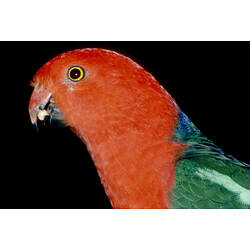General Description
Males have a bright red head, neck and underparts. Females have a green head and breast. Both sexes have a red belly, green wings and back, a pale green shoulder stripe, and a long green tail. Upper bill orange, lower bill dark grey. Body length is up to 45 cm.
Biology
Australian King-parrots are usually seen in pairs or small flocks. They forage mostly in trees, feeding on fruit and eucalypt and acacia seeds. King-Parrots nest in deep tree hollows, laying their eggs on a layer of decayed wood-dust. The nest entrance is high in the tree, while the nest and eggs are quite close to the ground. The clutch size is usually three to five eggs. They are largely sedentary. Australian King-Parrots are becoming more common in suburbs containing lots of trees and will feed at supplementary food tables and fruiting trees in urban areas.
Distribution
Eastern mainland Australia.
Habitat
Wet forests throughout mountain areas.
More Information
-
Animal Type
-
Animal SubType
-
Brief Id
A dark green and red parrot with a green-blue shoulder patch. Has a long, blunt tail.
-
Colours
Red, Green
-
Maximum Size
45 cm
-
Habitats
-
Diet
Herbivore
-
Diet Categories
Seeds
-
Endemicity
-
Commercial
No
-
Conservation Statuses
CITES: Trade restrictions (Appendix II), FFG Threatened List: Not listed, EPBC Act 1999: Not listed, IUCN Red List: Least Concern
-
Taxon Name
-
Scientific Author
(Lichtenstein, 1816)
-
Common Name
Australian King-parrot
-
Kingdom
-
Phylum
-
Subphylum
-
Class
-
Order
-
Family
-
Genus
-
Species Name
scapularis









